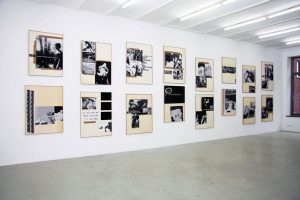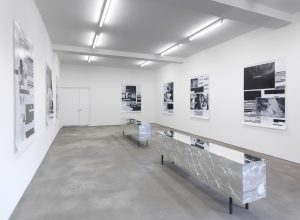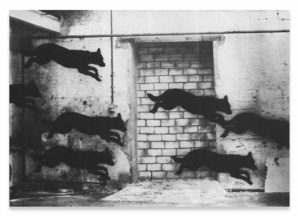Astrid Klein’s world is one of a shared history, of past tragedy and dark premonition with a subconsciousness of unnerving ‘reality’. It is expressive of a psychological state rather than grounded in a recognisable visual world. Entering the recent exhibition at the ICA one is confronted by the shadowy apocalyptic silhouette of the Brandenburg Gate rising up behind a terrain of heaped and erodedskulls, the monument has become a shade of itself and the ground turned to worn stone. The horror is indescribable, but the work locates it, through the subtitle Quadriga–a term most specifically used for the four horse drawn chariot as depicted in sculpture or on coins; that is already as a representation, already coded.
Born in Cologne in 1951 the artist’s vocabulary is circumscribed by a society which has struggled to suppress the devastation of its recent history. Direct references to the War and Fascism occur in juxtapostion with ideas of regeneration and ritual, as in Monte Albano . 30.1.33., (“oder die Gabelweihe”, translated as, or the consecration of the fork), 1987. 1983 takes the date Hitler came to power as its title. Throughout, decay and destruction, both literally and of the image struggle with the search for some other form of ‘seeing’ which might make hope possible. The word itself, in cyrillic, forms one recent work, (Hoffnung, kyrillisch). Writ large and sealed within the surface of the photograph it appears to hover between legibility and illegibility, between superimposition and erosion, between entirety and violent intrusion. A choice is possible–the work “Gabel” also means bifurcation.
The work has been described as that of ‘subversive displacement’ and can be located within a tradition of the politically engaged which undermines the authenticity of the photograph as document and accepts its status as a social sign within a system of value and power. Klein’s working methods are complex: negatives are extracted from newspapers and magazines voyeuristic fodder of everyday consumption–or taken by herself and the images fragmented, corroded with acid, submitted to double exposure, overlaid with grids, screens, enlarged to expose the half tone dots of the original reproductive technique, masked and stencilled and printed on paper coated with plastic resin to induce a particular diffuseness. She uses the term ‘photoworks’ to emphasize her intervention in the construction. The practice of working with the found mass media image and subverting its reading stems from the ‘avant gardes’ of the beginning of the century–the photomontages of Russian Constructivism and Dada, through that of Pop art to the pluralistic and deconstructive strategies of, and following Conceptualism–including text and image collage work, which Klein herself worked with in the late seventies.

In these earlier works the displacement came from the juxtapositions, which dislocate the original meaning and expose multiple readings; the found images themselves remained legible and referenced to visually observable world can be made. Since the early eighties she has refuted any vestige of the indexical nature of photography and its pretension to a realist model. The identifiable source, a given characteristic of the ‘photographic’, is denied and the structural elements of the medium used self-critically. In so doing she has exploited the potential for a ‘new instrument of vision’, to quote from Moholy–Nagy (1933). whilst acknowledging the precarious position of ‘authenticity’.
Her processes of fragmenting and violating the seamlessness of the photograph, combined with layering and enlarging, opens a new denser meaning beyond and behind the familiar. The photomontages and collages of the twenties and thirties had explored the representational possibilities of photography; much contemporary work unpicks cultural codes. Barbara Kruger for example through collisions of text and image, cropping and fragmenting, intercepts the stereotype, so dispelling and shifting representations which position women as the subject of the masculine gaze. Postmodernism in photography originally centred around the debates concerning the impossibility of reality outside and beyond representation, as for example in the work of Sherrie Levine or Cindy Sherman. The self is reflected everywhere, but in effect can be located nowhere. Klein’s use of the physical as well as intellectual deconstruction of the largely found image (and or more latterly text), so that it is no longer recognisable, so that not even the sign of the ‘real’ is graspable, places this as somewhere which is neither within that simulated reality nor fictitious. Its exploration is possible only within the constructed image itself. A logo-centric unified self is truly absent.
Horror as formed through the mass media is literally mediated, it is distanced and its  very representation tempers it reassuringly. Real horror cannot be coded and pictured, it is intangible. It is this intangibility which makes Klein’s work so powerful. People do not appear–they feature only as traces of actions, ambiguous outlines of ectoplasmic shadows, half-moments in a narrative; absences. In Endzeitgefuhle (translated as feelings about or intimations of the end of time), 1982, a place once occupied, now seen as empty with a bricked-up door is traversed by shadows of a huge jumping dog. The shadow is repeated, travelling to a point outside the ‘picture’; the viewers eye is denied perspectival access or entry into the space, one’s look is forced back. The individual components are relatively innocent but the scale of the work, its title, the shadows of life and the inability to actually penetrate the surface lead one to construct the scenario; the truth of the representation is doubted but the reality of fear is certain. This displacement–absence–and a sense of passing time pervades and is developed in the recent work. In the series Seduction and Slavery, 1988, absence is the necessary bedfellow of that which is desired, that which seduces–and slavery is the condition. Two vicious looking knives loom from a shadowy background, engraved with the words seduction and slavery. They pierce the flesh and at the same time their own cruelty upholds them. The words are clearly decipherable and seem to stand for that knife edge of existence where false horizons, the need to reinstate and project a certainty, to induce an ecstasy and an apparently better way of life, seduce only to become the masters in a game where individuality is denied. The false chances and hopes of this game are found in Seduction and Slavery IV, 1988 a chain of stone-like playing cards, dice and their shadows fill the image, crossing through the spectrum from light to dark. Klein’s earlier works had used as subjects those negative characters in our society–gamblers, dropouts, here she is abstracting the symbols of that submission to chance, to the joy of the moment which so often backfires and renegues on promise. For the first time direct reference is made to literary and philosophical sources, and indirectly to the role of art. In Seduction and Slavery V, she has taken Tamoe–de Sade’s utopia of 1788, the year before the French Revolution, when for the first time man as a creature of reason foresaw an alternative, planned future and since when those previous ‘acts of God’, war and all that comes in its wake, are excused as man’s tool for building a better life. The word is spelt out, almost with luminosity down the side of a leaning column–one of a row which extends beyond the boundary of the image. Although corroded at the base and at an angle, they retain a solid presence, on the one hand that of the past (most immediately that of the Third Reich), highlighted in its demise, and on the other suggest that utopia, is a world which knows no seduction and slavery, although shakily, established it cannot be discounted totally.
very representation tempers it reassuringly. Real horror cannot be coded and pictured, it is intangible. It is this intangibility which makes Klein’s work so powerful. People do not appear–they feature only as traces of actions, ambiguous outlines of ectoplasmic shadows, half-moments in a narrative; absences. In Endzeitgefuhle (translated as feelings about or intimations of the end of time), 1982, a place once occupied, now seen as empty with a bricked-up door is traversed by shadows of a huge jumping dog. The shadow is repeated, travelling to a point outside the ‘picture’; the viewers eye is denied perspectival access or entry into the space, one’s look is forced back. The individual components are relatively innocent but the scale of the work, its title, the shadows of life and the inability to actually penetrate the surface lead one to construct the scenario; the truth of the representation is doubted but the reality of fear is certain. This displacement–absence–and a sense of passing time pervades and is developed in the recent work. In the series Seduction and Slavery, 1988, absence is the necessary bedfellow of that which is desired, that which seduces–and slavery is the condition. Two vicious looking knives loom from a shadowy background, engraved with the words seduction and slavery. They pierce the flesh and at the same time their own cruelty upholds them. The words are clearly decipherable and seem to stand for that knife edge of existence where false horizons, the need to reinstate and project a certainty, to induce an ecstasy and an apparently better way of life, seduce only to become the masters in a game where individuality is denied. The false chances and hopes of this game are found in Seduction and Slavery IV, 1988 a chain of stone-like playing cards, dice and their shadows fill the image, crossing through the spectrum from light to dark. Klein’s earlier works had used as subjects those negative characters in our society–gamblers, dropouts, here she is abstracting the symbols of that submission to chance, to the joy of the moment which so often backfires and renegues on promise. For the first time direct reference is made to literary and philosophical sources, and indirectly to the role of art. In Seduction and Slavery V, she has taken Tamoe–de Sade’s utopia of 1788, the year before the French Revolution, when for the first time man as a creature of reason foresaw an alternative, planned future and since when those previous ‘acts of God’, war and all that comes in its wake, are excused as man’s tool for building a better life. The word is spelt out, almost with luminosity down the side of a leaning column–one of a row which extends beyond the boundary of the image. Although corroded at the base and at an angle, they retain a solid presence, on the one hand that of the past (most immediately that of the Third Reich), highlighted in its demise, and on the other suggest that utopia, is a world which knows no seduction and slavery, although shakily, established it cannot be discounted totally.
The passing of time, progress, the need to break its inevitable linearity and all too often entourage of destruction, is perhaps behind Klein’s latest series, Uber de Zeit (About Time)”, 1989. Here fragments of barely decipherable texts weave fragile correspondences with the images, and strange abstract signs imprint and punctuate the photographic surface, obscuring the ‘narrative’ behind and establishing themselves abruptly in the present. The images are almost recognisable, but the texts deliberately defy completion–in About Time III–the spectre of a strange masked face haunts the space, the text refers to lost time and memory, and chance and mishap (or luck and illfortune) are preferred to philosophy or understanding. It suggests that perhaps individuality still has a place. In number IV of the same series, a petrified flag-like form is accompanied by fragmetary allusions to ‘this time of Fascination’, the illusory ‘shine of life’, ‘incompleteness’ ‘weariness’, and it is suggested that forgetting does not hold the answer either, but perhaps ‘in the beginning’ … From within these dark worlds the flag might flutter again.
Gresty, Hilary
